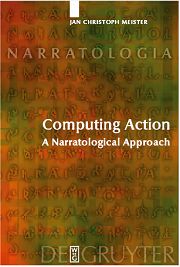
Jan Christoph Meister, Computing Action. A Narratological Approach, t. 2, 2003
The following gives an outline of the project which is described in detail in my book Computing Action. A Narratological Approach'.
(1) Based on a survey of philosophical definitions of the common sense concept of action' a constructivist notion of represented action was developed. (2) This approach was augmented by a semiologic definition of narrated action in the tradition of Greimassian theory which lead to a new definition of the narratological key concepts event', episode' and action' as combinatorial readerly constructs. (3) These narratological concepts were then implemented in a Humanities Computing methodology for the analysis of narrated actions. The development of two software tools was essential to the implementation of our theory: EventParser is a Markup tool that facilitates syntactically and conceptually consistent tagging and semantic declaration of events' in a narrative text. This program was developed in VB 6.0. - EpiTest is a program for combinatorial analysis of the potential for chaining these pre-defined events into episodes, and episodes into complex actions in accordance with the semiological criteria set down in the theoretical part of the study. EpiTest was written in PROLOG. - The software (including numerous protocol files and installation instructions) is available for download.
Table of contents:
Foreword by Marie-Laure Ryan
Acknowledgments
Introduction
1.1 Action as Project and Construct
1.2 Action: From Word to Concept
- The Etymology of the German Word Handlung
- Action as a Concept of Poetics
- Towards a Concept of Aesthetic Action
- Action I: Singular Agential Activity
- Action II: Complex (Multi-agential) Sequence of Events
- Action III: Discursive Meta-Activity
1.3 Philosophical Definitions of Action
- The Commonsense Concept of Action
- Analytical Definitions of Activity and Action
- Transcendental Definitions of Action
- The Constructivist Concept of Action
- Hegel: The Philosophical Value of Aesthetic Action
- Conclusions
1.4 The Elements of the Action Construct
- Lotman's Definition of the Event
- Structuralist Approaches: Event, Transformation, Move
- The Event as a Modal Change of State
- The Event as a Construct of Reception
- Event, Property and Matter
- Conditions of an EVENT
- Class-Homogenous EVENTS
- Class-Heterogenous EVENTS
- The Status of the Translation Rule
- World Knowledge and the EVENT
- Constructing events: An Example
- MATTER and FOCUS
- STATE OF AFFAIRS and OBJECT
- Constructing an object EVENT
- Constructing a discourse EVENT
- The EVENT Matrix
- The Referential Nature of the EVENT
- Definitions of the Episode
- The Formal Definition of the Episode
- The Semiotic Square: A Reappraisal
- The EPISODE: From Semiotic to Episodic Square
- The EPISODE as a Three-dimensional Construct
Part 2 The Computer-Aided Analysis of Narrated Action
2.1 Narratology and Literary Computing
- Narratology and the Cognitive Sciences
- The Limits of Practical Implementation
2.2 The EventParser Program
2.3 Constructing episodes and actions
- The Syntagmatic Link
- The Ontic Link
- The Semantic Link
- Closure
- The episode Matrix
2.4 The EpiTest Program
2.5 Action Potential and action Product
2.6 Practical Analysis Using EpiTest
Part 3 An Experiment in Action: Conversations of German Refugees
3.1 Critical Approaches to the Conversations
- The Compositional Logic of Goethe's Conversations
- Philosophical Discourses in Goethe's Conversations
3.2 Describing the Conversations
- The Isochronous Constructs
- The Isochronous and Anisochronous Constructs
3.3 Explaining the Conversations
- Goethe and the Unfathomability of the Weltbegebenheiten
- The Logic of ACTION in the Conversations
3.4 Conclusion